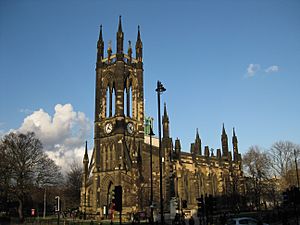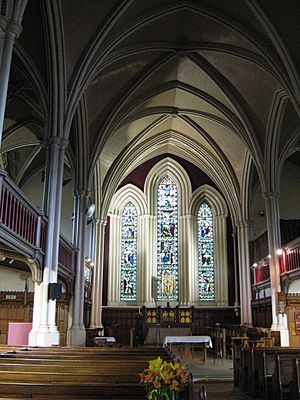Church of St Thomas the Martyr facts for kids
Quick facts for kids St Thomas the Martyr, Newcastle upon Tyne |
|
|---|---|

St Thomas the Martyr Church
|
|
| Denomination | Church of England |
| Churchmanship | Evangelical |
| History | |
| Dedication | St Thomas the Martyr |
| Administration | |
| Parish | none (see Legal Status) |
| Deanery | Newcastle Central Deanery |
| Archdeaconry | Northumberland |
| Diocese | Newcastle |
| Province | York |
The Church of St Thomas the Martyr (also known as St Thomas' Newcastle) is a famous church in Newcastle upon Tyne. It's easy to spot near the city's universities, the city hall, and the main shops in the Haymarket area. This church was rebuilt in the 1800s, but its history goes back to a much older chapel. People believe this first chapel was started by one of the knights who murdered Thomas Becket. In 2019, the church became a special "Resource Church" for the Diocese of Newcastle. Now, it's a growing church that's very popular with students and young people.
Contents
History of the Church
Why is it called St Thomas the Martyr?
The church is named after St Thomas Becket, who was the Archbishop of Canterbury. He was killed in 1170 by four English knights. They thought they were following orders from King Henry II. Thomas Becket had stood up for the Church's rights against the King. Because of this, he was seen as a martyr (someone who dies for their beliefs) and became a saint in 1173.
The four knights who killed him were told to do penance (show they were sorry). One of them, Hugh de Morville, Lord of Westmorland, might have decided to build a chapel (a small church) to say sorry. This chapel is thought to be the very first version of St Thomas the Martyr Church. We don't know the exact year it was built, but it was probably in the 1170s or early 1200s.
The First Chapel by the River
If Hugh de Morville did build the chapel, he put it right by the Tyne. Back then, there was only a wooden bridge across the river, where the Swing Bridge is now. By 1248, both the bridge and the chapel were looked after by a person called Lawrence.
In that year, a big fire destroyed much of Newcastle. The chapel was safe, but the bridge was badly damaged. Lawrence was in charge of getting money to rebuild the bridge in stone.
Later, in 1329, a man named William Heron started a special fund called a Chantry inside St Thomas's. This fund helped pay for prayers for the dead. The chapel also earned money from renting out cellars and from a windmill near Jesmond.
Moving to a New Home
There was an old hospital called St Mary Magdalene's Hospital outside Newcastle. It was built by King Henry I to help people with leprosy, a disease brought back by Crusaders. This hospital was near where Northumberland Street is today.
Even though it was a religious place, the hospital wasn't closed down during the big changes of the English Reformation in the 1500s. It continued to operate, eventually becoming a charity. King James I later joined the hospital and the Chapel of St Thomas the Martyr together.
In 1732, the leaders of Newcastle made the chapel more beautiful. It became a "chapel of ease," which meant it was a smaller church that helped the main St Nicholas Church. It could seat 300 people.
The old chapel was damaged by a flood in 1771. By 1827, people felt it needed to be replaced. So, the old chapel closed, and a new church was built on the site of St Mary Magdalene's Hospital.
Building the New Church
A famous Newcastle architect named John Dobson designed the new church. He created a beautiful building in the Gothic style. It cost about £6000 to build. The church you see today was built between 1827 and 1830.
Over the years, some changes were made. Galleries (balconies for seating) were added in 1837. In 1972, the altar area was changed to make the church more open. Today, the church is a Grade II* Listed Building, which means it's a very important historic building.
A New Church in Jesmond
In 1856, the leader of St Thomas's, Rev Richard Clayton, passed away. The church leaders wanted to appoint a new person, Clement Moody, who had different ideas about teaching the Bible. Many people in the church were unhappy about this.
So, a group of them decided to start a new church nearby. They wanted a place that would focus on teaching the Bible clearly. This new church, Jesmond Parish Church, was also designed by John Dobson and opened in 1861.
St Thomas's Today
How the Church is Run
The modern St Thomas the Martyr church is special because it doesn't have a specific "parish" (a local area it serves). It's run by a group called the Body Corporate, which includes the senior priest and church wardens. It also follows rules set by Acts of Parliament. It's part of the Diocese of Newcastle. The senior priest of the church is still called the Master.
Services and Community Role
Even without a parish, the church has regular services every week. These include a traditional service and a more modern service on Sundays, plus a service on Wednesdays.
St Thomas's is seen as a church for the whole city, including the universities and many other groups. It hosts many special events and services. Because it's so close to the City Hall and both Newcastle and Northumbria Universities, it often acts as a church for these big institutions. It also holds services for groups like the Royal British Legion and the Mothers’ Union.
In October 2019, St Thomas's became a "Resource Church" for the Diocese of Newcastle. This means it helps other churches grow. A new team came in, and the church quickly grew, attracting many young people each week.
Helping Others
St Thomas's is known for getting involved in social issues. They have supported big campaigns like Jubilee 2000 and Make Poverty History, which aimed to help poorer countries. They also support Fair Trade, which means making sure people who produce goods get a fair price for their work. The church even has a "One World Shop" that sells fairly traded items. They also support many other charities, both locally and around the world.
The Organ
The church has a large musical instrument called an organ. The first organ was built in 1832. A new organ was put in in 1902, and it has been rebuilt and improved several times since then.
Twinning
St Thomas's Church is twinned with the Parish Church of St Helier.
Images for kids




